

Flexcut 3 Draw Knife-Traditional Woodworker. Ladies Stacked Leather Heels. Welcome back fellow shoemakers of the world.
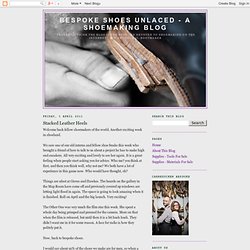
Another exciting week in shoeland. Leather. After a very pleasant Easter break which I spent painting, eating (yes, chocolate too) and generally resting, we are back with a short week.
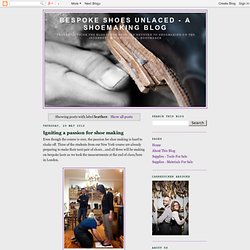
Now this would not normally be a cause for complaint, but, as usual, we have a glut of work all coming at once which needs doing immediately. The first few months of this year have been a bit quiet and we have taken the opportunity to do all the things which usually get shunted to the back of the queue, which is good in some ways, but now it's gone crazy. Finishing The Sole. Isn't life funny.
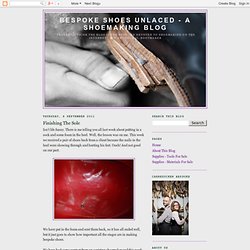
There is me telling you all last week about putting in a sock and some foam in the heel. Well, the lesson was on me. Finishing - Tips and Tricks. Greetings once again, dear readers and welcome to this week's post.
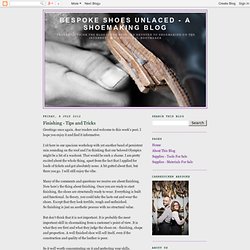
I hope you enjoy it and find it informative. I sit here in our spacious workshop with yet another band of persistent rain sounding on the roof and I'm thinking that our beloved Olympics might be a bit of a washout. That would be such a shame. I am pretty excited about the whole thing, apart from the fact that I applied for loads of tickets and got absolutely none. Fiddle Waist. So, dear shoemakers of the world, another week goes by.
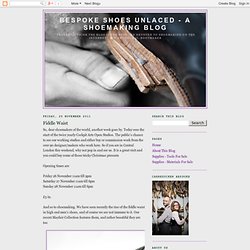
Today sees the start of the twice yearly Cockpit Arts Open Studios. The public's chance to see our working studios and either buy or commission work from the over 90 designer/makers who work here. Metal Shanks. Once more we meet, dear shoemaker folk of the world.

Bruce Johnson Leatherwork - leather tools. L’Indispensable Knife, Clicking Knife. Flat Knife and Brass Scabbard When I asked our manufacturer what tools were sold most often, I was surprised to hear that this little guy made it to the list.
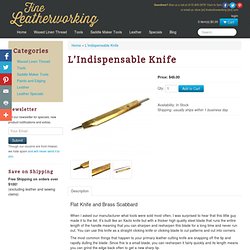
It’s bulit like an Xacto knife but with a thicker high quality steel blade that runs the entire length of the handle meaning that you can sharpen and resharpen this blade for a long time and never run out. You can use this knife as a straight clicking knife or clicking blade to cut patterns and cut into corners. The most common things that happen to your primary leather cutting knife are snapping off the tip and rapidly dulling the blade. Since this is a small blade, you can resharpen it fairly quickly and its length means you can grind the edge back often to get a new sharp tip. I Love Edward Green…..And You Should Too! – The Shoe Snob Blog. There are many reasons that companies become great and stay that way for many years after.

The fact that Edward Green has always been a industry leader in the high end/quality footwear sector, for me, is due to their constant ability to not forget the detail, or rather their ability to create a detail that is not only elegant and amazing, but that has never been done before. I can wholeheartedly say that I have never a medallion/brogueing done like this, where is just sits on the cap line as opposed to being positioned as a centerpiece. Medallions – The Shoe Snob Blog. I’M BACK!!!!
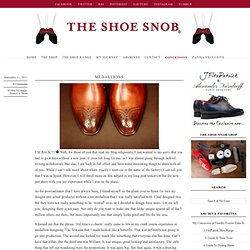
Well, for those of you that read my blog religiously, I just wanted to say sorry that you had to go 4 days without a new post. It even felt long for me, as I was almost going through lack-of-writing withdrawals. But alas, I am back in full effect and have some interesting things to share with all of you. Footwear of the Middle Ages - Some Stitches and Seams used in Sewing Shoes. In describing the stitches and seams used to make shoes, or do any other sort of leatherwork, it soon becomes clear that the traditional description conventions that have come to us from sewing with fabric are inadequate to that task with leather.

Up to a point, certainly, but soon things become needlessly confused. Moreover, shoemakers have their own nomenclature, much of which is unique to them. Further exacerbating the problem is that archaeologists and shoe conservators have created a jargon for describing shoes that is different from that used by shoemakers, either now or historically. The reasons for this are fairly simple, and mostly derive from the fact that the study of mechanics of shoe construction has a different focus from making shoes as a profession. One is interested in individual techniques, one in process. Western Boot Lasts, GC-975. Receipe for making glue. Glue to close the channel. DW, Hide glue is an old staple in woodworking shops. The stuff Nasser is making is used hot - but no more than 160 degrees. Luthiers use this glue a lot, and it can be purchased in flake form, with instructions as to how to reconstitute it. My father told me of working in a cabinet shop as a young man.
As the last hired, it was his job to get to work early enough to turn on the glue pot so it was hot enough to spread once everyone else got there. The hide glue is applied hot and sticks as it cools.